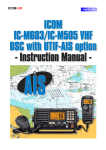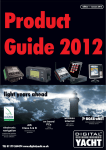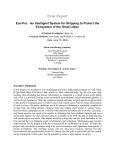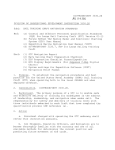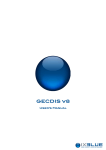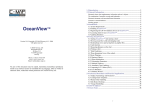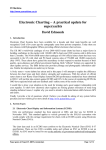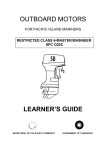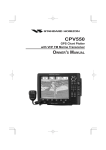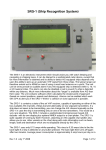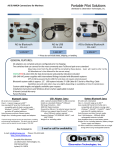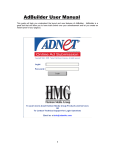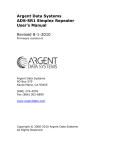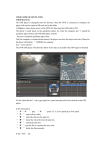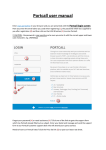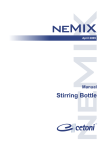Download (AIS). - Whitworths Marine & Leisure
Transcript
IC-M505 VHF MARINE with built in Automatic Identification System (AIS). I. Presenting AIS A. B. C. D. E. II. Introduction ............................................................................................................... Ships under an obligation to transmit in AIS ......................................................... Description of the AIS system ................................................................................. Dynamic information ................................................................................................ Static information...................................................................................................... ICOM AIS A. B. C. The Problem issue .................................................................................................... Intergrated Solution .................................................................................................. Description ................................................................................................................ III. Using AIS A. B. C. D. E. Principle for using an ICOM VHF radio AIS module............................................... Activation of AIS ....................................................................................................... Activation of scanning on the IC-M505 ................................................................... Explanation of basic operation ................................................................................ Advanced operation (*)............................................................................................. I. Presenting AIS A. Introduction Designed as a navigation aid in busy waters. The Automatic Identification System (AIS) was originally created by the Swede, Häkan Lans. B. Ships under an obligation to transmit in AIS The IMO (International Maritime Organisation) was responsable for making AIS compulsory for vessels under the SOLAS convention (Safety of Life at Sea). Vessels of 300 tonnes and over making international voyages must be equipped with AIS, as well as cargo vessels of 500 tonnes and over not intended for international voyages. Vessels meeting the above criteria, built after 1 July 2002, must be equipped with an approved AIS system. All other ships should have been equipped by July 1st 2008. C. Description of the AIS system The role of AIS signals is to transmit and receive nautical information such as speed, course and changes in course. Misunderstandings between vessels are thus avoided and VHF channels less overloaded. While radar provides basic information on the obstacles of a course, the AIS provides additional data on the navigation of nearby boats (if equipped with AIS transceivers). The AIS provides very accurate data such as the speed and actual course of boats, as well as other data such as their identification, size and sometimes their destination. The AIS is based on digital radio communications where various transceivers share transmission time. The system is theoretically limited to 75 boats: however, when a large number of boats are sailing in the same area, the AIS system automatically reduces it’s receive radius to give greater importance to the strongest/nearest signals retrieved. To avoid risks linked to a transmission channel breakdown, the AIS system functions in parallel on two frequencies in a frequency band dedicated to maritime traffic. These frequencies are set by default to (maritime channel 87B) and (maritime channel 88B). The data transmitted is time-staggered on the two channels in order to reduce refreshment time. This information is classified in two categories: dynamic and static types of information. D. Dynamic information This data is vital since it is relative to the "real time" movement of the vessel. The dynamic information sent by AIS signals is as follows: MMSI : ROT (Rate Of Turn): Navigation status: under sail Latitude: resolution Longitude:: resolution SOG (Speed Over Ground) 1/10ths of a knot COG (Course Over Ground): resolution True Heading (Gyro Compass): UTC Time for Creation of a Report: seconds Vessel identifier Rotation speed In port, manoeuvring, 1/10,000th minute 1/10,000th minute Actual speed in 1/10,000th minute Course in degrees Hours, minutes and (The refreshment time for this information may range from a few minutes to two seconds, depending on the speed and manoeuvre being undertaken by the vessel). E. Static information Every six minutes, additional static information is sent relative to the vessel and its current journey; for example, the name of the vessel, the onboard GPS position, the destination port, etc. II. ICOM AIS A. Problem issue At sea, it soon becomes apparent that, due to their size & maneuverability, Solas ships represent a definite risk for small, craft. Unfortunately little consideration is afforded to small craft, by these seagoing giants. The AIS system allows Mariners to monitor for possible collisions (Some Chart Plotters allow for proximity alarms). Additionally as the MMSI or (DSC number) is available (Via the AIS system) this allows for the selective calling of vessels, especially useful in emergency situations. B. Intergrated Solution On small craft, the need to have an on board receiver that decodes AIS Data soon became essential to keep skippers advised of potential risks of collision. To be efficient, the receiver must be of good quality with the position of the antenna as high & unobstructed as possible. These constraints are not very compatible with boats where the numerous aerials and equipment soon becomes a problem. For many sailing craft, a second coaxial cable in the mast is not an option. This is why Icom engineers sought to integrate the AIS decoder into a VHF radio, the aim being to take advantage of both the performance linked to the excellence of Icom receivers and easy installation for the user. No external casing or additional antenna are then required and craft benefit from the maximum range that a masthead antenna can give. C. Description The AIS signal is serialised with the ASN signal so that it can be used by an external system (software, plotter, etc.) on one serial port. With this generation, the GPS position can be added to the AIS and ASN phrases, still on one 4800 Baud port. There are a number of compatible onboard mapping systems (Shipplotter, Sw&N, Maxsea, Furuno, etc.). III. Using AIS A. Principle for using an ICOM VHF radio with a AIS module IMPORTANT: The following information is a supplement to the IC-M505 instruction manual. Please ensure you have read the IC-M505 manual before reading the following information. Once the VHF radio has been fitted with the AIS module, VHF reception simply needs to be activated manually on one or other of the AIS channels or by simultaneously scanning both AIS channels. (Programming will have been carried out beforehand to add the two AIS frequencies to the IC-M505 AIS, they are programmed as P1 & P2). The NMEA output must also be connected to the correctly configured final equipment. The IC-M505 AIS uses standard 9 pin D-Subminiature connectors for NMEA input & output. NMEA OUT Pin 2 NMEA out Pin 5 GND NMEA IN Pin 2 NMEA Pin 5 GND B. Activation of AIS The two AIS 1 (P1) and AIS 2 (P2) channels are marked by default with a TAG (see the VHF radio user manual to understand the role of the tag in scanning), which means they will be scanned when the scan function is activated. This is the easiest method of AIS implementation. You will thus continue to listen in to your favourite channels while AIS information is being regularly transmitted to the NMEA output and your chart plotter or PC. (The IC-M505 allows all Tagged channels to be cleared (Untagged) simultaneously please see the instructions. P13). C. Activation of scanning on the IC-M505 AIS Figure 7: Front panel of the IC-M505 AIS 1) Briefly press the Scan key, identified by the number 10 on the above view. Note: Channel 70 (DSC) is typically always scanned. The Radio can be set up for dual-watch or tri-watch scanning to listen in to channel 16, a preferred channel & a AIS Channel(s). (See the instructions for further information on dual-watch & tri-watch. P14). D. Explanation of basic operation The VHF radio, when in scanning mode will scan all the tagged channels, then will stop when it encounters a busy channel and then start scanning again when the channel is free. With each passage on the AIS channels, data will be transmitted to the navigation equipment to enable AIS targets to be displayed. IMPORTANT: An audible sound is emitted each time AIS data is received, this is normal. This is the easiest method of use and it is sufficient to enable AIS monitoring in the majority of cases. During VHF transmission or in active receive mode (audio open) on other channels, AIS data is not updated but this will occur when scanning next restarts. E. Advanced operation (*) (*) IMPORTANT: Advanced operation is an added safety measure permitted by the potential of this equipment; it is not necessary to use it during normal operation. In particular conditions (no visibility, very dense traffic, imminent danger of collision, etc.), if the skipper considers it pertinent for his safety not to scan any other channel and only use AIS channel reception, he has two options to obtain maximum information refreshment: 1°) Stop scanning and only monitor one or other of the AIS channels, chosen manually with the channel selection button. (Channels P1 or P2). 2) Scan only the two AIS channels by eliminating the tags of all other channels. (The IC-M505 allows all Tagged channels to be cleared (Untagged) simultaneously please see the instructions. P13). IMPORTANT: The use of a navigation aid does not release the skipper from the necessary vigilance in respect of the safety of equipment and people.






